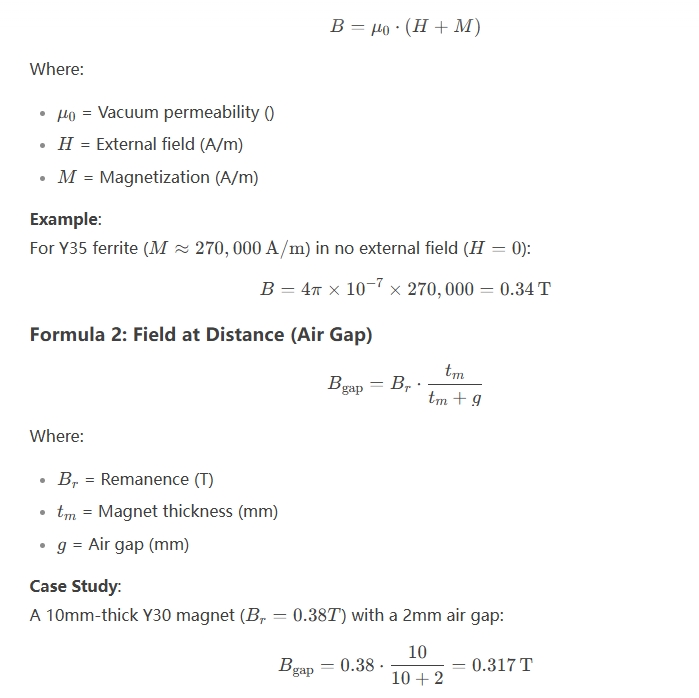How Strong Is a Ferrite Magnet? Calculation Methods & Industrial Applications
Ferrite magnets (ceramic magnets) dominate 68% of the global permanent magnet market due to their cost-effectiveness and corrosion resistance. But their magnetic field strength often raises critical questions: How strong are they compared to neodymium? How do engineers calculate their flux density in real-world applications? This guide provides data-backed answers and actionable calculation frameworks.
Ferrite Magnet Field Strength: Key Metrics
1. Typical Flux Density (Br)
Ferrite magnets exhibit intrinsic flux densities between 0.2–0.4 Tesla (T), with grades categorized as:
-
Y30: 0.38–0.40T (General purpose)
-
Y35: 0.40–0.43T (High-performance motors)
-
Anisotropic grades: Up to 0.45T (Directionally pressed)
Comparative Insight:
-
Neodymium (NdFeB): 1.0–1.4T
-
Alnico: 0.7–1.3T
2. Temperature Effects
Ferrite’s flux density decreases by 0.02% per °C above 20°C. At 180°C (max operating temp), flux drops by ~3.2%.
3. Demagnetization Resistance
With intrinsic coercivity (Hcj) of 200–400 kA/m, ferrite resists demagnetization better than alnico but underperforms NdFeB (800–2000 kA/m).
Step-by-Step Magnetic Field Calculation
Formula 1: Flux Density at Surface

Industrial Applications & Design Trade-Offs
1. Loudspeakers
-
Advantage: Low-cost ferrites (0.3T) suffice for consumer speakers.
-
Limitation: High-end systems use NdFeB to achieve >1.0T for deeper bass.
2. DC Motors
-
Design Fix: Compensate low Br by:
-
Increasing magnet volume (25% larger than NdFeB designs)
-
Using 8–12 stator poles (vs. 4–6 in NdFeB motors)
-
3. Magnetic Separators
-
Optimization: Stack ferrite blocks to create 0.6–0.8T zones for industrial recycling.
Ferrite vs. Neodymium: Cost-Benefit Analysis
| Parameter | Ferrite | NdFeB |
|---|---|---|
| Cost ($/kg) | 3–5 | 50–100 |
| Max Operating Temp | 180°C | 150°C |
| Corrosion Resistance | No coating needed | Epoxy/Ni coating |
| Energy Density | 3.5–4.5 MGOe | 35–52 MGOe |
Decision Matrix:
✅ Choose ferrite if: Budget <$10/magnet, temps <180°C, or corrosion-prone environments.
✅ Choose NdFeB if: Space-constrained, high-torque demands, or precision sensors.
3 Common Calculation Mistakes to Avoid
-
Ignoring Temperature Coefficients:
A Y35 magnet at 100°C delivers . -
Overlooking Shape Factors:
Ring magnets lose 15–20% flux vs. rectangular blocks due to magnetic path leakage. -
Misaligning Anisotropic Axes:
Improper alignment in anisotropic ferrites reduces Br by 30–50%.
Free Calculation Tools & Resources
-
FEMM Software: Open-source FEA for magnetic simulations.
-
K&J Magnetics Calculator: Online flux density estimator.
-
IEC 60404-15 Standards: Test protocols for hard ferrite materials.
Need Custom Solutions?
Contact us at sales01@tecomag.net for:
-
Ferrite grade selection
-
Magnetic circuit prototyping
-
ISO-certified performance reports










